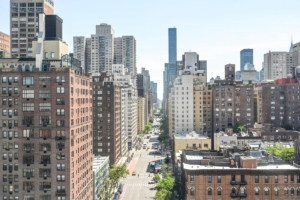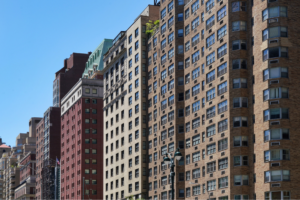Sales price growth will continue to slow in Manhattan and Brooklyn over the next 12 months. This is our latest forecast as a new year settles upon the city’s residential real estate market. Some of the most definitive trends of 2015 have persisted in the new year, however. In January, inventory continued to shrink in the sales and rental markets. Constrained inventory has allowed sales price growth to remain positive for both boroughs, with median resale prices reaching new heights in both boroughs in January.
January’s report also points to emerging trends that may set 2016 apart from last year. Rent prices may finally begin to stabilize, as monthly growth remained flat over the winter months. In addition, after a period of blistering sales price growth in Manhattan, there is evidence of greater buyer fatigue setting in on the borough’s sales market.
Here are some of the leading trends from StreetEasy’s January market data:
Upper Manhattan Sale Price Growth Slows, While East Brooklyn Continues to Accelerate
The median resale price in Manhattan grew 5.3 percent from last January to $991,468, according to the StreetEasy Price Indices, continuing a steady decline in annual price growth since the heady months of the first half of 2014. Since February 2014, the annual median resale price in Manhattan has grown at a consistently slower pace with each new month as the market settles into a slower growth pattern. Price growth is expected to slow further in 2016. According to the latest StreetEasy Price Forecast, the median resale price in Manhattan will grow by 4.1 percent to $1,032,128 by January 2017.
The Upper Manhattan submarket led price growth in Manhattan, where the median resale price grew by 10.3 percent from last year to $623,017. While its annual price growth is nearly double the Manhattan-wide pace, the rate has been slowly falling in recent months. At its recent peak in August 2015, annual price growth in Upper Manhattan hit 12.9 percent but has since slowed.
Elsewhere in Manhattan, annual price growth was clustered around 6 percent. In the borough’s Upper West Side submarket, the median resale price grew 6.1 percent from last year, followed by Downtown (5.9 percent) and Upper East Side (5.8 percent). The black sheep of the borough is Midtown, which posted a significantly lower annual growth rate (2.2 percent) in January, a stark reduction from the 8.7 percent annual growth rate it enjoyed last January.
Overall price growth in Brooklyn is higher than Manhattan. The median resale price in Brooklyn grew 8.5 percent from last year to $540,186, according to the StreetEasy Price Indices, although monthly growth has slowed in recent months. The median resale price was unchanged from December and has consistently slowed down since July 2015. Brooklyn price growth is expected to continue cooling over the course of 2016. According to the StreetEasy Price Forecast, the median resale price in Brooklyn will grow by 3.7 percent to $560,032 by January 2017.
Despite an expected slowdown in price growth across Brooklyn, the East Brooklyn submarket has shown no signs of slowing. The median resale price in the East Brooklyn submarket grew 25.3 percent from last year to $494,564, the highest annual growth recorded in any submarket at any point in StreetEasy records. East Brooklyn neighborhoods like Crown Heights and Bedford-Stuyvesant, which have sales prices that are low relative to the rest of Brooklyn, have attracted more prospective buyers as housing and retail options there have experienced a rapid transformation. Increased demand for the relative value of East Brooklyn has fueled its record-setting price growth over the last year.
Elsewhere in Brooklyn, price growth has been far slower than East Brooklyn’s. In the borough’s Prospect Park submarket, the median resale price grew by 10.3 percent from last year, followed by North Brooklyn (7.7 percent), South Brooklyn (7.6 percent) and Northwest Brooklyn (4.7 percent). There are early signs of a significant price cooling in the Northwest Brooklyn, Prospect Park and South Brooklyn submarkets: Monthly price growth has been negative in each of these submarkets since October, November and December, respectively. Overall growth in Brooklyn may have been stunted by these recent price declines, but strong growth in East and South Brooklyn may have more than made up for it.
[tableau server=”public.tableau.com” workbook=”priceIndices” view=”StreetEasyPriceIndex” tabs=”no” toolbar=”no” revert=”” refresh=”yes” linktarget=”” width=”600px” height=”770px”][/tableau]
As Prices Reach New Highs, ‘Buyer Fatigue’ Sets In
The Manhattan market showed mixed signs of competitiveness in January relative to last year: The size and prevalence of discounts declined slightly, but time on market increased significantly in a possible sign of buyer fatigue setting into the market.
The number of homes that saw a price discount as a share of all homes available for sale in January fell from 34.1 percent last year to 31.1 percent. The typical discount size in January also fell slightly from last year, from 7.1 to 6.7 percent. Coupled with the 5.3 percent annual growth in median resale price across Manhattan, January’s discount data points to a more competitive market as sellers concede fewer discounts at higher overall prices. However, homes that went into contract in January typically spent 90 days on the market, nine days longer than last year — a sign that buyers were more reluctant to purchase a new home than last year. While homes typically take more time to sell during the cold and slower months of winter, January’s median time on market of 90 days was the longest since January 2013, indicating that there could be more than routine seasonality at play.
According to the same three key market indicators – number of discounts, size of discount and time on market – the Brooklyn sales market was less competitive than last year. The number of homes that saw a price discount as a share of all homes available for sale in January rose from 25.7 percent to 26.0 percent. The typical discount size in January also inched up slightly from 6.1 percent to 6.3 percent. Similar to Manhattan, buyers in Brooklyn were far more hesitant than last year. Homes that went into contract in January typically spent 85 days on the market, a full 18 days longer than last year. Condo units, which accounted for 45.5 percent of the borough’s pending sales in January, saw the most extreme slowdown. The typical time on market for condos that went into contract in January was 103 days, 45 days longer than last year.
[tableau server=”public.tableau.com” workbook=”January2016MarketOverview” view=”domWindow” tabs=”no” toolbar=”no” revert=”” refresh=”yes” linktarget=”” width=”600px” height=”670px”][/tableau]
Rent Price Growth Begins to Stabilize
Rents continue to grow across Manhattan and Brooklyn, but recently the growth rate has slowed. The median rent price in Manhattan grew 4.2 percent from last year to $3,114, according to the StreetEasy Rent Indices. For the third consecutive month, however, monthly growth was essentially flat: The median rent price fell 0.2 percent from December. Annual rent growth was the strongest in the Upper East Side submarket, which saw 5.4 percent growth, followed by Upper West Side (5.1 percent), Midtown (4.9 percent), Upper Manhattan (4.3 percent) and Downtown (2.9 percent).
Brooklyn rentals have experienced a similar slowing. The median rent price grew 2.1 percent from last year to $2,636 according to the StreetEasy Rent Indices. Monthly growth was essentially flat for the last two months: The median rent price fell 0.2 percent from December. Annual rent growth was the strongest in the Prospect Park submarket, which saw 4.8 percent growth, followed by North Brooklyn (3.9 percent), Northwest Brooklyn (2.7 percent) and East Brooklyn (1.1 percent). In South Brooklyn, the median rent price fell 2.6 percent from last year to $1,623 in January, the only submarket in Manhattan or Brooklyn that experienced an annual decline in rent.
Explore detailed neighborhood-level data in the chart below:
[tableau server=”public.tableau.com” workbook=”January2016MarketOverview” view=”NeighborhoodData” tabs=”no” toolbar=”no” revert=”” refresh=”yes” linktarget=”” width=”600px” height=”870px”][/tableau]









